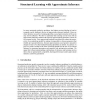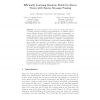IJAR
2008
14 years 9 days ago
2008
This paper presents a family of algorithms for approximate inference in credal networks (that is, models based on directed acyclic graphs and set-valued probabilities) that contai...
UAI
2008
14 years 1 months ago
2008
Graphical models are usually learned without regard to the cost of doing inference with them. As a result, even if a good model is learned, it may perform poorly at prediction, be...
NIPS
2007
14 years 1 months ago
2007
In many structured prediction problems, the highest-scoring labeling is hard to compute exactly, leading to the use of approximate inference methods. However, when inference is us...
ECAI
2008
Springer
14 years 2 months ago
2008
Springer
Abstract. Two approaches have been used to perform approximate inference in Bayesian networks for which exact inference is infeasible: employing an approximation algorithm, or appr...
AAAI
2008
14 years 2 months ago
2008
We propose a novel method for approximate inference in Bayesian networks (BNs). The idea is to sample data from a BN, learn a latent tree model (LTM) from the data offline, and wh...
SIGMOD
2010
ACM
14 years 5 months ago
2010
ACM
Real-world databases often contain syntactic and semantic errors, in spite of integrity constraints and other safety measures incorporated into modern DBMSs. We present ERACER, an...
ISIPTA
2005
IEEE
14 years 5 months ago
2005
IEEE
Graph-theoretical representations for sets of probability measures (credal networks) generally display high complexity, and approximate inference seems to be a natural solution fo...
ICML
2008
IEEE
15 years 1 months ago
2008
IEEE
Deep Belief Networks (DBN's) are generative models that contain many layers of hidden variables. Efficient greedy algorithms for learning and approximate inference have allow...
ECCV
2008
Springer
15 years 2 months ago
2008
Springer
As richer models for stereo vision are constructed, there is a growing interest in learning model parameters. To estimate parameters in Markov Random Field (MRF) based stereo formu...




